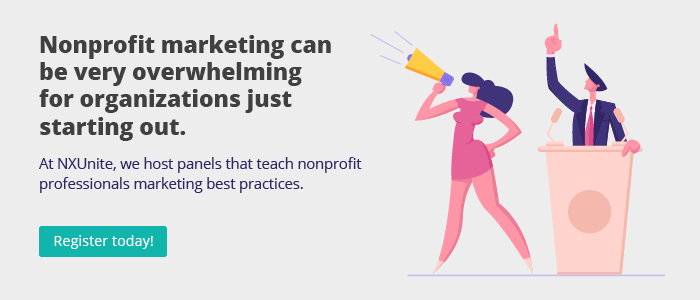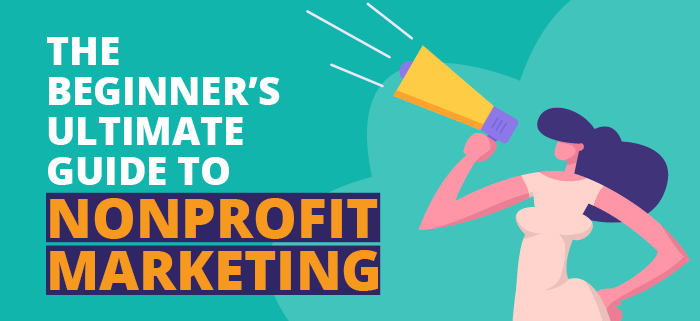The Beginner’s Ultimate Guide to Nonprofit Marketing
As a nonprofit professional, you know that staying within your organization’s budget often requires a little creativity. Especially when it comes to nonprofit marketing, your team might have lavish ideas and big plans without the resources to pursue them.
However, nonprofit marketing is vital to the continued success of your organization. It’s how you spread the word about your nonprofit’s upcoming events and opportunities and get people excited about contributing to your cause. Without a strong nonprofit marketing plan, it’ll be difficult to move forward and pursue your mission effectively.
Additionally, there are a lot of considerations that go into successful nonprofit marketing. That’s why we’ve created this nonprofit marketing guide. We’ll teach you the basics as well as strategies you can use to promote your organization, even on a budget.
Here are the topics we’ll cover in this article:
- What is Nonprofit Marketing?
- Developing a Nonprofit Marketing Plan
- Nonprofit Marketing Strategies
- Nonprofit Marketing Ideas
Here at NXUnite, we connect organizations with various resources to help them in all areas of nonprofit operations. Marketing is crucial for nonprofits because it’s how people find your organization, learn about your cause, and contribute to your organization. We understand how tricky it can be to come up with a marketing strategy on a small budget, so we’re happy to provide this ultimate nonprofit marketing guide to help you out.

With that, let’s introduce what nonprofit marketing is and what it can do for your organization!

What is Nonprofit Marketing?
Nonprofit marketing is when mission-based organizations use promotional strategies to educate others about their cause and garner support. It’s an essential part of introducing your organization to people who may want to become involved, including prospective donors, volunteers, and board members.
For your current supporters, nonprofit marketing allows you to inform them about upcoming events and opportunities. You’ll want to grab your supporters’ attention and get them excited about what you have in store.
While implementing effective nonprofit marketing takes work, it can offer your organization a variety of benefits. If you stay organized and follow a detailed plan, nonprofit marketing can help you:
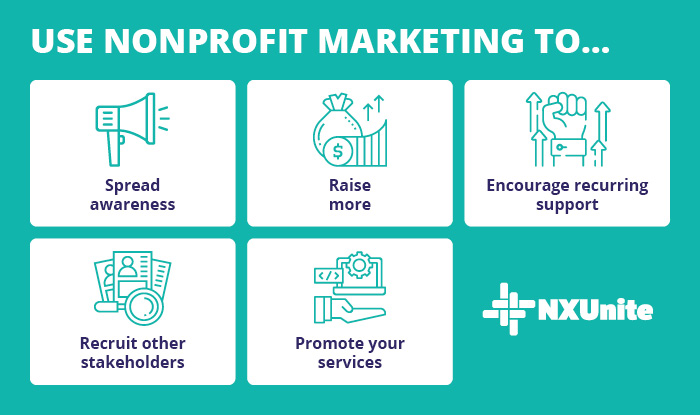
- Spread awareness. At the core of your nonprofit is your mission. Investing time in a marketing plan will not only help to promote your organization, but also educate people about your nonprofit’s cause.
- Raise more. The more people know about your organization, the more fundraising potential your organization has.
- Encourage recurring support. Of course, your nonprofit should appreciate each and every donation it receives. However, recurring donations provide a steady, consistent funding source. They also present the opportunity to build strong relationships with your long-term donors. Effective marketing can encourage donors to continue their support for your organization.
- Recruit other stakeholders. While crucial to your organization’s success, donations are not the only form of support people can lend to your nonprofit. Effective marketing will allow you to recruit other supporters for your organization, such as volunteers, members, event attendees, and board members.
- Promote your services. Potential supporters want to know exactly what steps your organization does to advance your mission. That way, they can decide if they’re interested in joining in. Using a well-developed marketing plan will ensure that your organization’s services are clear to interested parties.
To complete all of the objectives above, it’s not enough to just start posting on social media or adding articles to your website’s blog. You’ll first need to come up with a comprehensive marketing plan that outlines your marketing strategy across multiple channels.

Developing a Nonprofit Marketing Plan
To effectively promote your organization, you must set clear intentions for your marketing efforts. That’s why you need a nonprofit marketing plan.
Creating a comprehensive marketing plan ensures that you stay organized and focused on your goals throughout your marketing efforts. With all of the details planned ahead of time, you’ll be able to focus on creating well-designed promotional materials and getting people excited about your cause.
If you’ve never come up with a marketing plan before, it can be intimidating. To help you out, we’ve provided you with the major steps you’ll need to follow to create your own:
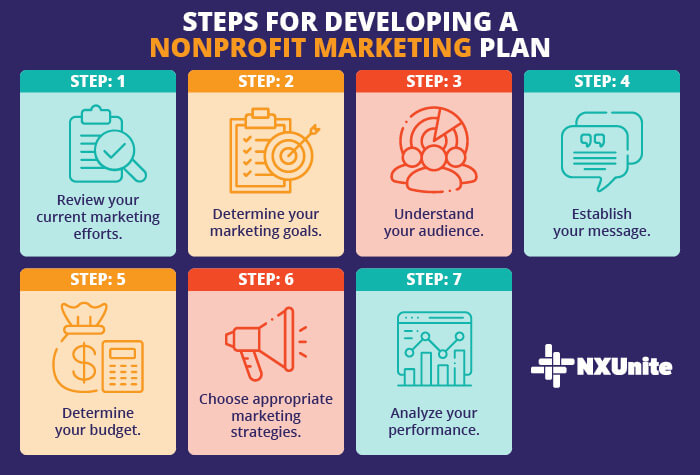
Step 1) Review your current marketing efforts.
It’s always good to take inventory of your current nonprofit marketing efforts. That way, you can figure out what successful elements you should continue implementing and what changes you’ll need to make. For a formal marketing audit, you can perform a SWOT analysis. Here’s what it entails:
- Strengths. Start off strong by describing what your organization does well.
- Weaknesses. Recognize any areas your nonprofit can improve upon.
- Opportunities. Identify potential external factors that could help your marketing efforts succeed.
- Threats. Pinpoint any factors that could potentially harm your marketing efforts.
This in-depth analysis will propel your new marketing efforts forward.
Step 2) Determine your marketing goals.
Just as your mission guides your overall operations, your marketing goals should inform your marketing efforts. Of course, you should keep your mission in mind and make sure your marketing goals serve that mission. It’s best to form SMART goals to make sure your goals are clear and meaningful. SMART stands for:
- Specific. Create goals with a certain initiative or event in mind.
- Measurable. Make sure you can track your goals with relevant performance metrics.
- Attainable. Keep your nonprofit’s resources and capabilities in mind.
- Relevant. Develop goals that will further your mission.
- Time-based. Hold your organization accountable by assigning a time frame to your goals.
In addition to following the SMART acronym, you’ll also want to list your goals by priority so you know which ones to divert the most resources to.
Step 3) Understand your audience.
Your audience is likely comprised of different groups such as donors, volunteers, and board members. Make sure you define each audience and their needs. To segment your audience even further, think about the different subcategories of your supporters.
Step 4) Establish your message.
To hone your nonprofit marketing efforts, you’ll want to boil your goals down to a few key messages you’d like to share. These messages should be unique to your organization and able to grab your supporters’ attention. To go along with your message, the language, calls-to-action, and visuals you’ll use should all be outlined as well.
Step 5) Determine your budget.
It’s tricky as a nonprofit to accomplish your marketing goals with few resources. To make use of what you have, you’ll want to determine a budget for your promotional efforts. If you don’t think you’ll have enough to make your goals a reality, try applying for a nonprofit marketing grant. Grantmaking organizations offer free funding for the purpose of promoting your organization and its services, making it a great way to power your marketing efforts.
Step 6) Choose appropriate marketing strategies.
The different marketing strategies or channels you choose to spread your mission should align with your goals and audience. From direct mail to social media, there’s a lot you can do to promote your cause.
In the next section, we’ll go over nonprofit marketing strategies you can use to promote your organization.
Step 7) Analyze your performance.
It’s important to keep track of your progress and performance using data. That way, you’ll know what worked and what needs to be changed for future campaigns. Choose metrics to track that will represent your definition of success. For example, if you’re implementing a social media campaign, you might want to track the number of shares, likes, and comments on your relevant posts.
As you can see, there are many things to consider when developing your nonprofit marketing plan. It can take time to complete a well-rounded plan, but it will be worth it to have your marketing goals, logistics, and strategy all in one place.

Nonprofit Marketing Strategies
There are plenty of ways to promote your organization. However, you should be careful to choose your nonprofit marketing strategies so that they align with your goals and audience. For example, if you’re targeting an older audience, it might not be the best idea to use social media as your main form of outreach.
The great thing about nonprofit marketing channels is that you can use them in tandem with each other. You will naturally want to promote your events via email and share your blog posts on social media. This way, you’re creating as many touchpoints as possible so your supporters can contribute to your cause in the way that works best for them.
To help you determine which nonprofit marketing strategies are best for your organization’s current needs, we’ve listed some of our favorites below:
- Google Ad Grants
- Print Marketing
- Email Marketing
- Direct Mail Marketing
- Event Marketing
- Video Marketing
- Social Media Marketing
- Website Marketing
- Content Marketing
- Text Message Marketing
Click on the ones you’re interested in to learn more or scroll through to check them all out!

Google Ad Grants for Nonprofits
Google Ads provide a way for nonprofits to promote their services and mission in Google search results. If someone searches for a term related to your organization, they can find your organization’s website as an ad at the top of the search results and navigate to one of your pages.
However, it can get expensive to run Google Ads. That’s exactly why Google offers an option for nonprofits called Google Ad Grants. The Google Ad Grants program provides eligible nonprofits with $10,000 per month in ad credits. That way, your organization can expand its reach in a way that aligns with its budget.
Through the program, you can market a range of content, including everything from your donation page to educational content. It’s up to you to pick the right keywords and develop ads that target those search queries.
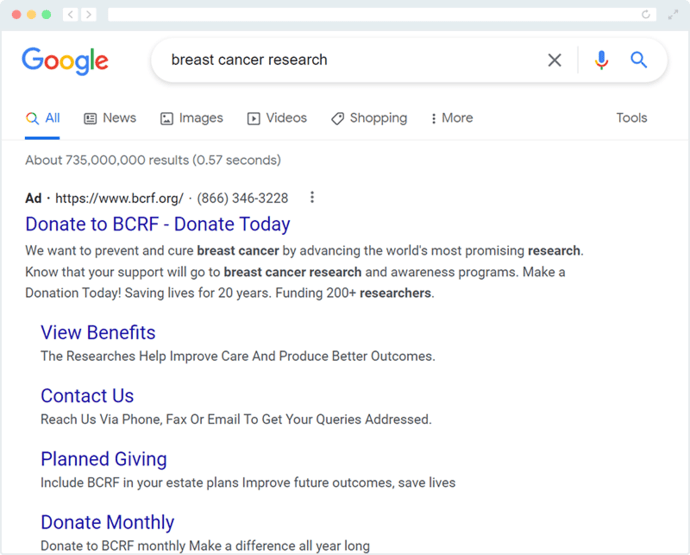
As long as your organization is eligible and follows all program guidelines, it’s easy to get started. You can even work with a dedicated Google Grants agency for help with the application process or account maintenance.
We recommend the experts at Getting Attention. These individuals know the ins and outs of the program, striving to supercharge your ads and amplify your mission online.

Print Marketing
While the digital landscape helps break down geographical barriers, print marketing is a fantastic way to connect with your local audience members. Some nonprofits view it as “old-fashioned” or “outdated,” but print marketing is still a major force in the world of advertising.
Think about the last time you saw a poster for an upcoming event or received a flyer in the mail. When you consider how frequently you personally come across printed marketing materials, you’ll notice that it’s still prominent in people’s everyday lives even with the rise of digital marketing.
In a world driven by quick communication, people rarely see printed communication that they care about. Among stacks of junk mail and bills, a well-designed fundraising flyer is much more likely to catch their eye and mean something to them.
When dabbling in print marketing, there are plenty of options your nonprofit can use, including:
- Flyers and posters
- Brochures and pamphlets
- Newspaper and magazine ads
- Yard signs
Particularly for nonprofits, this type of marketing can help you connect with older supporters who aren’t as active online. Plus, many people interpret it as being more personal since it takes a bit more effort than sending mass emails or publishing a social media post.
No matter what type of print materials you create, you’ll want to make sure they’re designed to catch people’s eyes. Your graphics, fonts, and colors can mean the difference between someone stopping to read your ad and going on about their day without a second thought.
If graphic design isn’t your marketing team’s forte, consider hiring a third-party designer. We recommend Kwala! They work exclusively with nonprofits to produce professional marketing materials for both print and digital outreach.
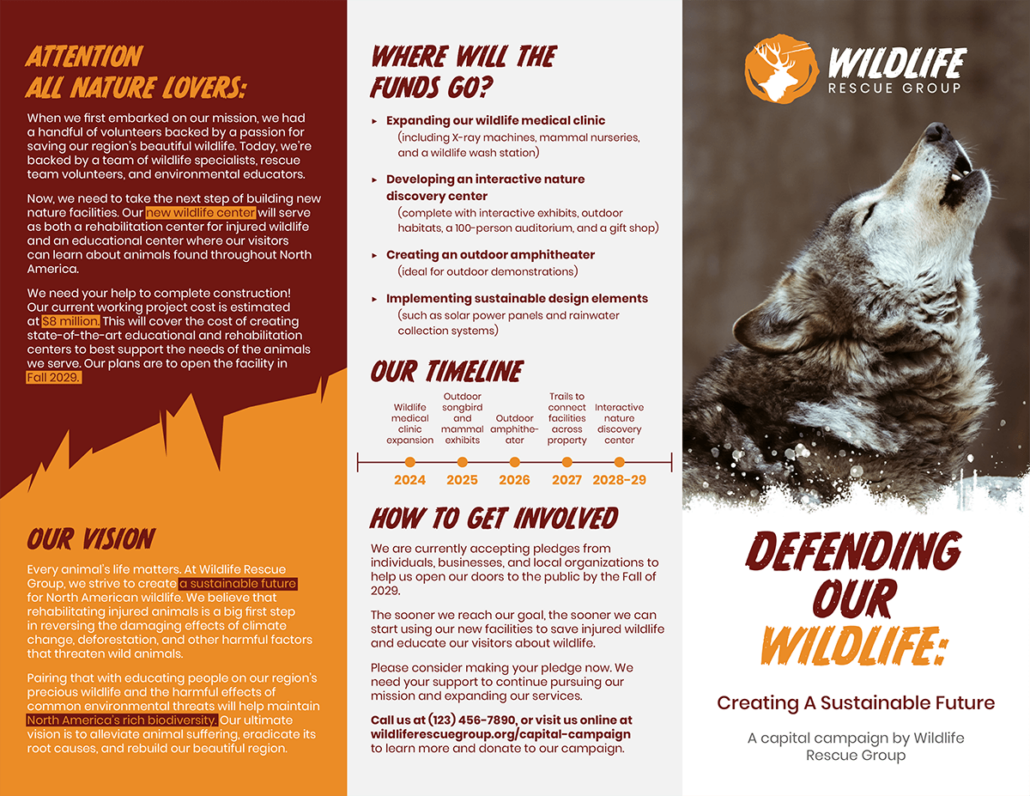
They design everything from letterheads to capital campaign brochures, like the example above! Reach out to their team to start creating powerful designs for your nonprofit marketing materials.

Email Marketing for Nonprofits
So many nonprofit marketers rely on email marketing. It allows you to reach supporters of all ages and types, including donors, volunteers, event attendees, and board members. Since a large variety of people use email regularly, email marketing has a high ROI and is an easy way to stay connected with your supporters.
Additionally, it’s extremely easy to personalize emails using segmentation tools and email marketing software. That way, you can make your supporters feel special and send them information specific to their involvement with your organization.
Here are some ideas for using email marketing effectively:
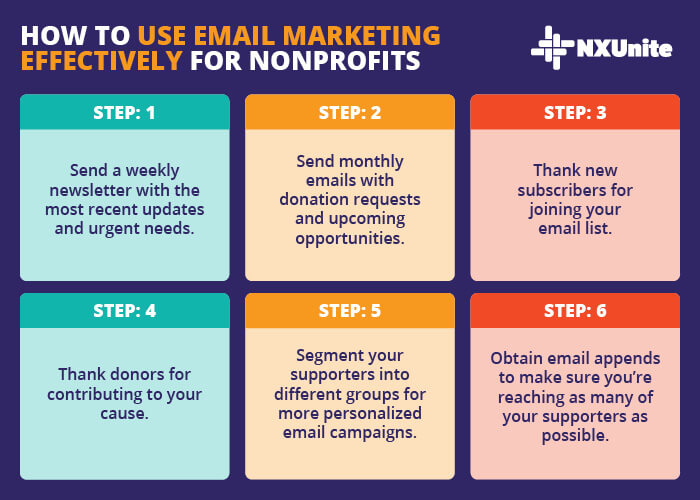
- Send a weekly newsletter with the most recent updates and urgent needs.
- Send monthly emails with donation requests and upcoming opportunities.
- Thank new subscribers for joining your email list with an automatic reply.
- Thank donors for contributing to your cause with an automated email.
- Segment your supporters into different groups for more personalized email campaigns.
- Append email addresses to make sure you have accurate contact information and can reach as many of your supporters as possible.
Considering how easy it is to draft and automate emails, email marketing is a great choice for promoting your organization and sharing news with your supporters.

Direct Mail Marketing for Nonprofits
Although many nonprofit marketers think direct mail is dead, it actually has a higher response rate than emails. Perhaps this is because direct mail is even more personal than emails, and people acknowledge the extra time that went into the campaign, especially if you’re using segmentation.
Additionally, the letters you send your supporters serve as physical reminders of your organization and their involvement. Having something tangible that’s associated with your nonprofit may encourage supporters to donate or attend one of your events.
You can create direct mail campaigns for donation requests, event invitations, thank you letters, and more. While you can use direct mail to simply inform people about your organization, it’s best to include a call-to-action to ensure the time and funds you put into your campaign pay off.
To help you create direct mail campaigns that drive your supporters to take action, we’ve compiled some tips:
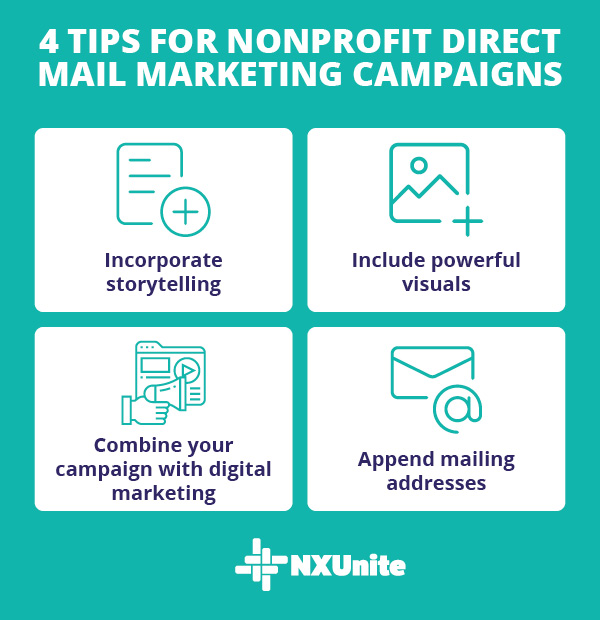
- Incorporate storytelling. Make your direct mail outreach even more personal with strong storytelling. While facts and statistics are helpful for understanding what your organization does, people want to feel a connection with your nonprofit. For example, if your organization is an animal shelter, tell your supporters about a dog you’ve rescued and given a better life. Seeing the impact your organization has had will inspire people to become a part of it.
- Include powerful visuals. People are drawn to images/ Plus, visually-engaging images help to break up text, make content easier to read, and can help communicate your message. Your supporters will get more out of your letter if you include meaningful visuals that connect to the copy you’ve written. Consider using pictures of real people your organization has helped or informative graphics that illustrate different points you’ve made.
- Combine your campaign with digital marketing. While direct mail is an effective outreach method, you can make it more engaging by connecting it to your online marketing efforts. Including a QR code that connects to an event registration page or listing your social media handles will allow your supporters to navigate smoothly across different digital marketing channels.
- Append mailing addresses. How useful can your direct mail campaign be without your supporters’ addresses? You might not have all the mailing addresses for your supporters, but working with a data append service can help you obtain the information and put it to good use.
Direct mail is a great way to show your supporters you care about them. However, it’s important to regularly check your supporters’ communication preferences to make sure they’re okay with receiving letters from you.

Event Marketing for Nonprofits
Hosting an event provides a chance for people to get to know your organization in person. You can form a connection with potential supporters and tell them directly about the impact they could make on your organization.
There’s a wide range of events your nonprofit can host. If you have the budget for a more lavish event, try hosting a gala. To get your supporters up and active, organize a marathon. The possibilities are endless!
No matter which type of event you’re hosting, there are some general ways to make sure your event is successful at accomplishing your goals. For the ultimate nonprofit event, make sure to:
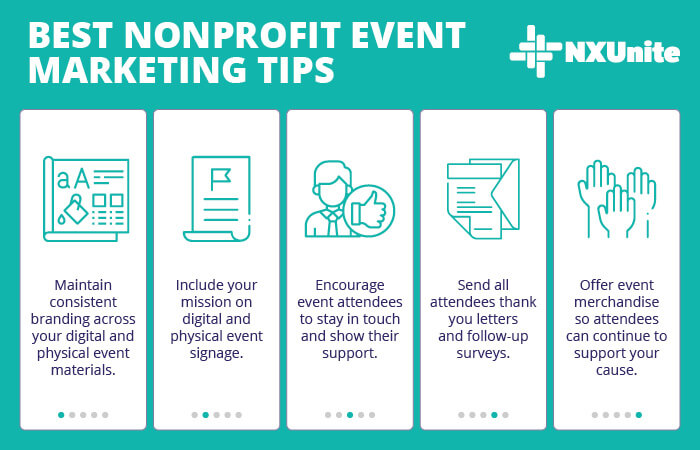
- Maintain consistent branding across your digital and physical event materials.
- Include your mission on digital and physical event signage.
- Encourage event attendees to stay in touch and show their support.
- Send all attendees thank you letters and follow-up surveys.
- Offer event merchandise so attendees can continue to support your cause.
While they do take a lot of time and resources to plan, events are powerful nonprofit marketing tools. People will remember their experience at your event and retain that association between their enjoyment and your nonprofit.

Video Marketing for Nonprofits
Video marketing has become very popular in recent years, and it’s easy to see why. Videos are even more engaging than static images and can allow you to share an abundance of information in a short amount of time.
While YouTube was one of the first modern video-sharing platforms, others such as TikTok and Instagram have caught onto the short video craze. Nonprofits can take advantage of these platforms to promote their events and missions.
There are several reasons why video marketing is so impactful, including:
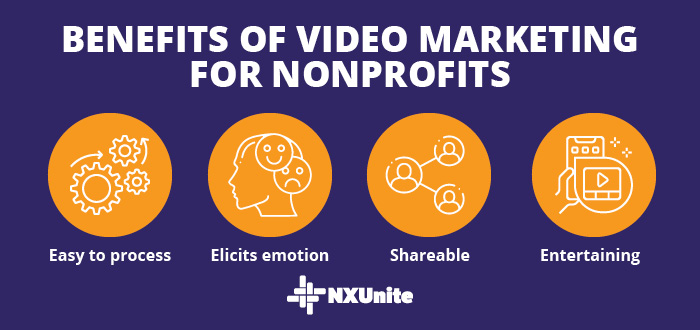
- Easy to process. Did you know that people process visual content 60,000 times faster than written content? This makes it easier to inform your audience about your mission or upcoming opportunities.
- Elicits emotion. Reading a paragraph or looking at an image could make you feel something, but it’s much more likely for a video to move you. This emotion can inspire action and a deeper connection to your cause.
- Shareable. Social media platforms make it easy to send videos to your friends over text or through the apps themselves. This way, your supporters can help amplify your cause for you.
- Entertaining. Most people would simply prefer to watch a video to learn about a topic as opposed to reading about it. Videos make topics come to life and will do a better job of capturing your audience’s attention.
While we’ve mostly discussed video marketing in the context of social media, that’s not the only place you can share videos your organization has created. Consider creating an informational video to live on your website’s homepage or a thank you video to send to donors after they’ve contributed.
Videos are extremely valuable marketing tools, but note that they can also slow down the load time of your website. Remember to turn off auto-play to help your website load as quickly as possible.

Social Media Marketing for Nonprofits
Since social media is free, it’s a great marketing choice for nonprofits. It also encourages interaction with your organization and its content. People can comment, like, and repost your content, maximizing its impact.
Social media also gives your organization the opportunity to leverage current trends and build a brand personality. Recently, small brands have blown up on TikTok for their funny and relatable content, and there’s no reason why nonprofits can’t do the same.
Although there’s a variety of social media platforms that all feature different types of content, follow these suggestions to improve your organization’s online presence:
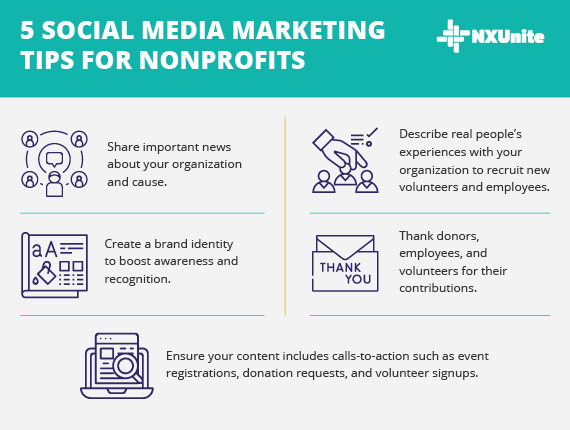
- Share important news about your organization and cause.
- Create a brand identity to boost awareness and recognition.
- Ensure your content includes calls-to-action such as event registrations, donation requests, and volunteer signups.
- Describe real people’s experiences with your organization to recruit new volunteers and employees.
- Thank donors, employees, and volunteers for their contributions.
Considering the number of different social media platforms out there, you’ll want to think hard about which ones fit best with your audience, content, and mission.
If you’re looking to fundraise, Facebook and Instagram are great choices because they have built-in peer-to-peer fundraising features. However, if your goal is to rally young supporters around your cause, TikTok may be a better fit. Be strategic about your organization’s social media presence for the best results.

Website Marketing for Nonprofits
Your nonprofit’s website is likely the first place people go to learn more about your organization, so it’s important to do it right. Your website should not only host valuable information about your organization, but it should also inform supporters about upcoming events and opportunities.
Whether you’re creating your nonprofit’s website or optimizing it, use these tips to make your website ready and engaging for users:
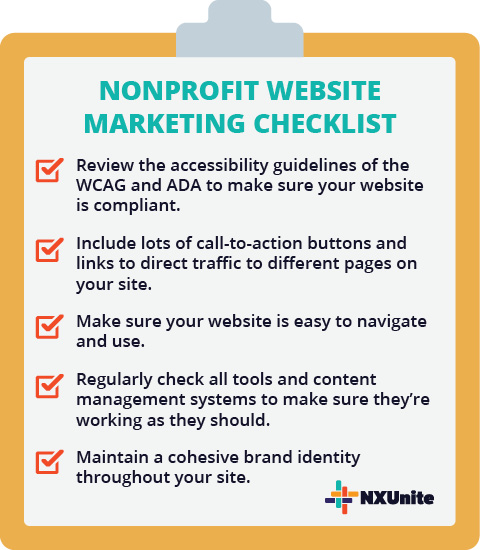
- Review the WCAG and ADA guidelines to make sure your website is compliant.
- Include well-placed call-to-action buttons and links to direct traffic to different pages on your site.
- Make sure your website is easy to navigate and use.
- Regularly check all tools and content management systems to make sure they’re working as they should.
- Maintain a cohesive brand identity throughout your site.
Think about your website as the hub of supporter activity. It’s where you collect donations, share updates, describe events, and educate people about your cause. Since your website has several functions and purposes, it’s important to make sure it’s working properly and is designed effectively to provide a positive user experience.
Between following the above tips and ensuring your graphic design strategy inspires users to explore your site, your site will be well-equipped to be your ultimate marketing asset.

Content Marketing for Nonprofits
Content marketing allows you to create valuable nonprofit content that can bring traffic to your website and build your reputation in the field. You can create standard blog posts as well as downloadable resources.
To help you get started with content marketing, here are some different types of content you may leverage:
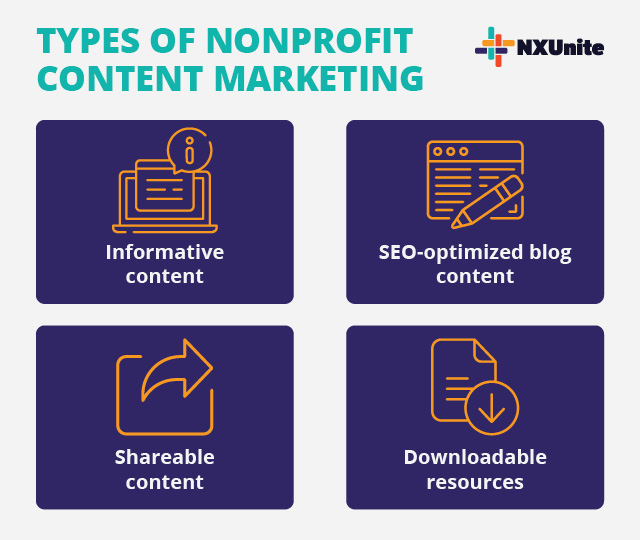
- Informative content about your mission or news in your field
- Typical blog content that’s SEO optimized to help with your page’s search engine rankings
- Shareable content that can help spread your mission further
- Ready-to-use templates and downloadable resources for others to use
Writing content takes a lot of time and effort, so you may want to consider creating a copywriting team for your organization. That way, you can have a group dedicated to filling your blog and adding value to your website.

Text Message Marketing for Nonprofits
Since people are always on their phones, text message marketing has a high open rate and the potential to reach your audience quickly.
One way to use text message marketing effectively is by leveraging a text-giving tool. That way, you can create effective text-to-give campaigns that provide an easy donation option.
You can also use phone appends to make sure you reach all of your supporters. Phone appends fill in the missing phone numbers in your supporter database and update outdated ones. Having this data helps to ensure that you’re reaching out to the right people with the right contact information.
Besides initiating a text-to-give campaign, there are other opportunities for text message marketing. You can use this outreach method to:
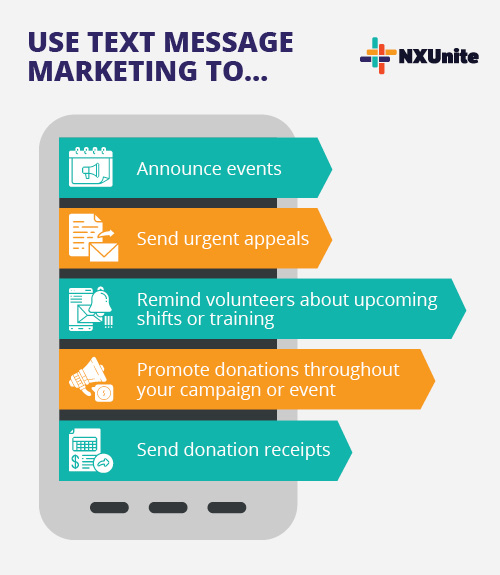
- Announce events
- Send urgent appeals
- Remind volunteers about upcoming shifts or training
- Promote donations throughout your campaign or event
- Send donation receipts
While similar to email marketing, text message marketing is better for shorter messages and encouraging your supporters to take action. With a higher open rate, text message marketing allows you to reach your supporters in a way that’s convenient for them.
Beyond the few we discussed, there are so many more nonprofit marketing strategies your organization can leverage. Remember, don’t overwhelm your marketing team. Think about the purpose of your campaign and the characteristics of your audience, and choose the right platforms for your nonprofit. That way, you can reach out to supporters through different channels without wasting time and resources on unviable options.

Nonprofit Marketing Ideas
It can be difficult to come up with specific ideas for how to market your nonprofit, especially for organizations just starting out. There are so many things to keep in mind, which can quickly become overwhelming.
To help you out, we’ve narrowed down some of the most essential nonprofit marketing ideas to make your campaigns stand out, including:
Develop design, personality, and attitude guidelines.
If you want people to recognize your organization’s branding, then you have to make sure it’s cohesive. Work with your nonprofit marketing team to carefully develop your nonprofit’s persona and graphic design preferences.
Commit to improving your content’s SEO.
It’s important to know how to optimize your content for search engines and which factors contribute to your content’s rankings. Research SEO best practices and determine the top keywords you want your content to rank for.
Establish a connected online presence.
We’ve discussed different digital marketing strategies. Whichever ones you choose to implement, it’s best to create paths that connect each platform to each other. For example, include the link to your website in the bio of your social media accounts. That way, people can go straight from one touchpoint to another seamlessly.
Create a nonprofit marketing budget.
One of the most important parts of your marketing plan is your budget. You’ll want to make sure you can gather all the resources you need to promote your organization effectively while still staying within your organization’s means.
Analyze your data.
If your organization isn’t constantly reviewing the data it has and making decisions based on that data, then you’re missing out on crucial opportunities to grow your nonprofit. Data provides concrete evidence for what your marketing team is doing well and what they could work on. Some metrics you could track include:
- Clickthrough rate (CTR)
- Conversion rate
- Email open rate
- Social media impressions and reach
Keeping track of the data associated with your campaigns allows you to improve your future marketing endeavors.
Emulate larger organizations.
The great part about starting a nonprofit is that there are thousands of model organizations to base your strategies on. Find an organization similar to yours and see how they’ve reached success to help inform your own nonprofit marketing efforts.
Implement segmentation.
Dividing your supporters into groups based on shared factors allows you to customize their experiences. That way, you can demonstrate that you understand your supporters’ needs and are willing to meet them where they are.
Personalize your supporters’ experiences.
Segmentation isn’t the only way to give people a personalized experience. Consider sending handwritten thank you cards to your donors or featuring a volunteer of the month on your social media pages. Showing your supporters that you care will only deepen their connection to your organization.
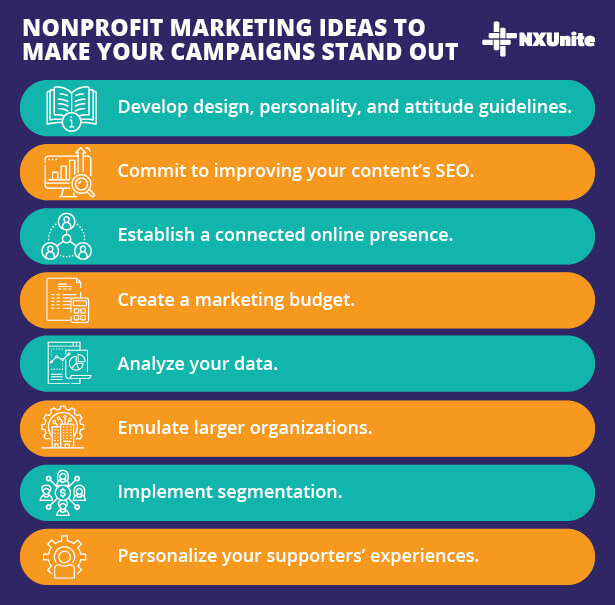
Above all else, it’s important to continuously review your marketing efforts. That way, you can adapt to any new trends or identify any areas that need some work. Just because your organization was up to date five years ago doesn’t mean you can’t change your branding or segmentation to be more current to the present day.
Remember, your number one consideration should be your supporters. All of your promotional efforts are directed at gaining and retaining supporters, so it’s necessary to think about their needs and keep them in mind throughout the whole nonprofit marketing process.

Conclusion and Additional Resources
Now that you know all about nonprofit marketing, it’ll be easier to dive right into the process. Equipped with a marketing plan, strategies, and ideas, you’ll be all set to start reaching out to potential supporters and growing your nonprofit.
While we went over the basics of nonprofit marketing in this guide, there are still so many areas that you can dive into. Especially if you’re a newer nonprofit marketing professional, you’ll likely want some additional resources to look over.
Here are some articles that can teach you a little more about nonprofit marketing:
- Nonprofit Marketing Ideas: Promote Your Cause Effectively. Looking for more nonprofit marketing ideas? This guide will walk you through different categories of marketing ideas to help promote your organization.
- Marketing Analytics: A Guide for Marketing Professionals. As we mentioned, it’s important to review data from your campaigns and adjust them as needed. Check out this article for help with your marketing analytics.
- 18 Free & Discounted Nonprofit Marketing Tools to Use Today. Check out our list of the top eighteen free or discounted marketing tools to empower your mission on a budget.
- Microsoft Ad Grants: The Complete Guide for Nonprofits. Microsoft offers a program that’s similar to Google Ad Grants. Learn how to market your mission on Bing, Yahoo, and other search engines with this guide from the experts at Getting Attention.
